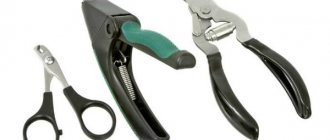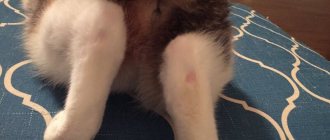Why do cats have their claws trimmed?
It is vital for cats to have their claws ground down, because as new ones grow, the old ones come off. When living freely, climbing fences and trees, natural grinding occurs. Living indoors, cats need to wear off their old claws. Many cats enjoy using special scratching posts. These can be ready-made complexes or home-made devices.
But some cats and cats either ignore the offered draperies. Another problem may be excessive aggressiveness of animals, which manifests itself in scratches and snags on clothing. If there is a small child in the family, then communication with a cat may result in injury to the child . After all, small children want to play with it, but do not understand that the animal can experience pain and “give back.” Therefore, it is necessary to minimize the risk of injury to children.
Do cats themselves take care of their claws?
Furry predators have been watching their claws since birth: licking, gnawing, sharpening on all kinds of objects. Your pet's readiness to hunt depends on the appearance and length of the claws - too long or blunt claws will not allow you to catch and hold prey. Paradoxically, stray cats and those to whom their owners pay little attention find themselves in an advantageous position. A free lifestyle with unlimited climbing of fences and trees helps to maintain the “weapons of struggle” in proper condition. Domestic cats, walking under strict supervision, cannot cope with claws on their own; they need help from their owners.
How to circumcise?
Let's figure out how to trim a cat's claws correctly. First of all, we recommend purchasing special tools.
Circumcision tools
The owner should know that the claws cannot be trimmed with ordinary scissors, otherwise this may lead to problems. Pet stores sell claw clippers. Their shape ensures that the entire nail is captured. You may also be offered guillotine pliers for cat claws, which allow you to perform the trimming procedure more efficiently. If you haven’t been able to buy nail clippers yet, you can use guillotine-type nail clippers for human nails.
Haircut instructions
How often do cats need to have their nails trimmed? At home, the procedure is carried out at least once a month. When asked how to properly trim, veterinarians advise first of all to carefully study the structure of the claw. If you hold the claw up to the light, you can see the pink interior inside the white transparent part. An important point is that you need to cut it so as not to touch the tissue where the blood vessels pass.
Haircut order:
- It is necessary to choose a time when the cat is in a calm state. Having sat her on her knees, caressed her, they begin the procedure.
- Taking your pet's paw, you need to press your finger so that the claw sticks out as much as possible. The cat's claws are trimmed by placing the nail clipper perpendicular to the plane of the claw, moving a few millimeters away from the pink fabric. In one motion, cut off the sharp part.
- If tissue is accidentally caught and blood appears, it is necessary to wash the wound with hydrogen peroxide. At first, it is better to keep peroxide on hand. If the animal is restless, then two people perform the haircut: one holds the cat, the other trims it.
- Be sure to trim the claw located on the side of the front legs.
It is better to accustom cats to the procedure of circumcision from a young age. If the kitten begins to scratch, tear up furniture, and climb curtains, then you can start trimming the very tip of the claws. Cats' claws are trimmed starting at three months of age.
It seems to many that animals experience discomfort during and after trimming their claws. But old claws, which the cat needs to “rip off,” also cause inconvenience.
Any cat or cat breed, including Sphynx, Scottish, British and all others, needs to be able to trim their nails correctly, which become a real problem when keeping animals at home. At home, they tear up furniture and also scratch everything that they can find that is suitable for this purpose. That is why it will not be superfluous to do a haircut correctly. Of course, you can go to the veterinarian for this task, but you can also achieve similar results at home with your own hands.
How often should a cat's nails be trimmed?
Cats that are not allowed outside need to have their nails trimmed regularly. In a young healthy animal, the frequency of nail trimming is 2-3 weeks. Outdoor cats and male cats do not have their claws trimmed. They serve as protection and food for them.
How to cut the claws of a cat on its hind legs and is it possible to do this?
The owner decides whether it is necessary to cut the cat's claws on its hind legs. Usually it is enough to do a cat manicure only on the front paws of the animal, because it is with the front paws that the cat most often scratches or causes material damage. If your pet is too active, likes to climb on curtains and carpets (or for other reasons, because each animal has its own character), for the sake of its own safety, you can and should trim the claws on its hind legs.
How to properly trim a cat's claws at home
To trim the claws, you will need scissors or small nippers, as well as manganese to disinfect any possible wounds. Lay the cat down so that it is convenient for you to carry out this procedure. Take the animal's paw and lightly press on its pad - the cat will involuntarily release its claws.
They cut the edge of the claw to the place where it begins to turn pink - this is where the pulp with nerve endings and blood vessels begins, so if you touch it and cut more than necessary, blood will immediately appear. Then, in order to avoid infection and to stop bleeding, the wound will need to be immediately sprinkled with manganese crystals.
How to trim a British cat's claws
British breed cats have their nails trimmed once every 3 weeks or as the claws grow. The procedure is absolutely painless for the cat, the main thing is not to hurt the blood vessels. The beginning of the danger zone is clearly visible if you examine a cat's claw in the light, so the “manicure” should be done during the day or in good lighting. It’s a good idea to accustom your kitten to a scratching post from an early age, then you and your pet will have fewer disagreements about what the upholstery on an armchair or sofa is for.
How to trim a cat's claws with ordinary scissors, nippers, tweezers
If you choose whether to trim your cat's claws with regular scissors, nippers or tweezers, then nippers or tweezers will be preferable. Scissors, especially blunt ones, can split the claw. But in general, you can work with the tool that is more convenient for you. The main thing is that the cutting surface of the device is sharp and disinfected. But this is the opinion of ordinary cat lovers. Veterinarians have a slightly different opinion and recommend purchasing special nail clippers for cutting nails.
If you have decided on the tool, then you can begin the process of trimming the claws. Use your thumb and forefinger to squeeze the cat's paw pad until it releases its claws. Take a close look and trim the edge of the claw, just short of where the claw begins to turn pink. The pulp is located here, and it should not be injured under any circumstances. You only need to trim the very edge!
Don't worry, the procedure is painless for your cat, and removing old, dehiscent claws will give your cat relief. In a couple of weeks, your pet's claws will grow back, but now stronger and healthier.
How to cut a cat's claws at home with guillotine scissors, guillotine
The scary phrase “guillotine scissors” or “guillotine” is actually a very convenient device for trimming pets’ nails. Having such a tool, trimming a cat’s claws is a matter of five minutes. The main thing is to be careful and attentive. In order not to touch the blood vessels present in the claw and not cause delamination of the claw, you need to cut the guillotine strictly perpendicular to the claw. The dewclaw, located on the inside of the paw, is trimmed in a similar manner.
How to properly cut a cat's claws with special scissors or a nail clipper
Special scissors or a nail clipper are taken in the right hand so that the thumb rests on the lever. The cat is placed in your arms and, by lightly pressing on the paw pad, is forced to release its claws. Carefully examine the claw to see the border of the beginning of the pulp. Place the dead section of the claw in the nail clipper perpendicular to the blade of the tool. Press the claw cutter lever firmly and cut off the intended part of the claw.
How to trim a cat's claws with pruning shears
To trim a cat's claws, it is better to use a special nail clipper-secateurs. Secateurs, unlike ordinary scissors, make an even cut and the claw does not delaminate in the future. There are many varieties of nail clippers produced, so before using the tool you need to carefully study the instructions supplied with it. The main thing is not to damage the claw pulp when cutting. If the border of its beginning is difficult to see, and this often happens in cats with dark claws, it is better to play it safe and cut off only the sharp part of the claw, about 2 mm long.
How to trim a Scottish cat's claws
Scottish cats are very intelligent. It is not at all difficult to accustom them to hygiene procedures, including cutting nails. The manicure of a Scottish cat is no different from caring for the claws of its other relatives. The main thing when cutting is not to damage the pulp and the blood vessels located in it. If you are careful, this will not happen, since the claws of cats of this breed are translucent and the border between the dead area and the pulp can be seen very clearly.
Rules
Every owner should know how to properly trim a cat's claws, since the animal requires this procedure regularly. The entire manipulation can be divided into several stages:
Wash your hands and disinfect the tools.
After the animal is securely fixed, you should take the paw and press on the pads of the toes so that the claw comes out and is clearly visible.
The tool should be positioned at right angles to the nail being trimmed, from top to bottom.
If the claw is light-colored, then trimming is done within 1 - 2 mm of the pink area. If there is pigmentation, cut 1 - 2 mm from the tip of the nail, being careful not to touch the capillary. Typically, dark nails are trimmed in stages to prevent bleeding.
The nail should be trimmed in one step (in one motion).
You should not delay the manipulation so as not to irritate your pet. If a blood vessel is accidentally damaged, apply a cotton pad soaked in hydrogen peroxide or chlorhexidine solution to the nail to stop the bleeding. If the damage is significant, you should contact a veterinary clinic. But, as a rule, with some skill and experience, the procedure is quick and painless.
To learn how to properly trim a cat's claws, watch this video:
There is nothing complicated about how to cut a cat's nails. To ensure the procedure goes without complications, you should follow the advice of experienced breeders:
Claws should only be trimmed with sharp tools. Dull forceps or scissors will lead to the claw breaking and splitting.
It is best to carry out the procedure in bright daylight, so the border where the blood capillaries end is better visible.
After trimming, the claws must be treated with a hard file or emery block. This polishing will ensure a smooth surface of the plate and prevent creases and snags.
If it is impossible to carry out the procedure in one step, it is better to do it in stages, without stressing the pet.
It is not advisable to carry out several hygiene procedures at once. For example, in addition to trimming, bathe the animal on the same day.
If the pet fiercely resists the procedure and the owner is afraid of harming the animal, you can seek help from a veterinarian.
How to trim a cat's claws?
All cat owners know what tattered furniture, torn curtains and scratched hands mean. Of course, no one likes this, and owners are looking for ways to avoid this. Special scratching posts do not always solve the problem; complete removal of claws is considered a very difficult intervention, so many owners are interested in whether it is possible to trim a cat’s claws?
Of course, animals that move a lot and walk outside do not need this, because their claws wear down naturally from climbing trees and walking on asphalt. But pets are deprived of this. Due to a sedentary lifestyle and lack of ability to climb and jump, cats often grow very long claws. They cling to carpets and furniture, break, and can interfere with the animal’s walking. In this case, many veterinarians answer the question: Do they cut cats’ claws in the affirmative? But this is not always necessary.
If there is a child in the house who cannot control his communication with the animal. Your pet's long claws can cause pain to your baby.
The fifth claw, which is never worn down, also needs to be trimmed. As it grows, it can grow into the skin, causing suffering to the cat.
When trimming nails, it is important to follow certain rules so as not to cause pain to the cat or cause inflammation. The claw in animals has a complex structure; inside it there are blood vessels and nerves. You need to know how to trim a cat's claws correctly so as not to cause bleeding, so that they do not split and this does not cause suffering to the animal. The claws on the hind legs are shorter and do not need to be cut. You should regularly check your pet's paws and, if necessary, do a manicure.
To do this, be sure to use a special tool. Do not cut your nails with regular scissors under any circumstances - the nail plate will split. You can use manicures
Source
Your cat's nails should be trimmed to prevent them from peeling or breaking. In addition, it is useful to cut off the sharp ends if the cat likes to scratch and trample with its paws. This is a fairly simple procedure if you learn how to do everything correctly. In this article we will talk about how this is done.
Stroke the cat's paws.
Many cats naturally do not like to have their paws touched, so first you need to get your pet used to touching.
Start gently stroking the cat's paws, stroking it in places where it likes it (on the top and bottom of the neck, at the junction of the back and tail, and so on).
The cat may curl up its paws or even get up and walk away. Don't interfere with this. Don't force it, but try to pet your cat's paws whenever possible.
Every time your cat lets you pet her paws, give her treats and praise her so that she has pleasant associations with this process.
Examine the animal's claws.
Over time, the cat will begin to calmly allow you to squeeze its paws (you should press on the pads) so that the claws appear on the surface.
The pink area is the living part of the nail, which consists of blood vessels and nerves, so if you accidentally hit this area with a nail clipper, it will be very painful for your cat. Always trim only the top of the nail - it is important to cut only the pointed edge.
Look closely at the claw and find out how large the live area is. The claw itself is transparent, so the living area is easy to notice - it is a pink triangle. All of the cat's claws will look the same. If your cat has dark claws, try to find one that is transparent and go from there.
Get your cat used to the nail trimming position.
If your cat sits correctly, she will be less likely to struggle during the procedure.
If you trim the claws yourself, you will need to sit the cat on your knee with its muzzle
Source
Cat and cat All the most interesting things about cats and cats
A normal dog would never let his nails be cut.
As a rule, a dog can be accustomed to anything with a treat and a kind word. If possible, this should be done from puppyhood. “For very nervous comrades, there is this method: first take a regular comb and scratch the paws and claws, praise the dog if it does not pull its paw away, give it a treat. If the dog does not react to scratching in any way, except for glances in your direction, click the nail clipper next to the paw and praise again. After the dog begins to take this calmly, you can proceed directly to the haircut,” recommends groomer A. Gil.
How to Trim a Cat's Nails: 6 Steps to Soft Paws
When a small kitten or an adult cat appears in the house, every owner thinks about how to properly care for the animal’s claws. Is it possible to trim the claws of cats and kittens, as well as how to trim the claws of a cat or kitten correctly - will be discussed in this article.
Cats need to be accustomed to manicure procedures from a young age. Kittens perceive trimming their claws as an entertaining game, and it is much easier to deal with a small kitten than with an adult cat. In addition, if your home is undergoing renovations and expensive furniture, then the answer to the question of whether cats need to trim their claws comes naturally.
It is very important to know how to trim a cat’s claws correctly, because the claws are part of the paws, and if you do not trim them skillfully, you can damage the blood vessels, which can cause the cat to suffer greatly in the future.
If you are planning to trim your cat's claws, it would be a good idea to find out what tools can be used for this cat manicure procedure. Surely, you have something from the list below in your home.
Kitchen scissors, sewing scissors, and office scissors are not suitable for trimming cats' nails. Tools for trimming cat claws should be made of stainless steel, and it is advisable to have rubberized handles where the fingers grip the tool.
I use nail clippers to trim my cat's nails. But this tool is quite specific, so if you are cutting a cat's claws for the first time, practice on yourself first.
2. Take the cat in your arms and sit with it on a chair near a window or other light source. To trim a cat's claws correctly and not damage the blood vessels on the claw, you need to see everything clearly, so we need good light.
3. Sit the cat down
Source
Cosmetics
Dog owners often complain about constant clicking noises in the house. Annoying sounds encourage owners to contact specialists to solve this problem. And then special caps for claws come to the rescue. They are made of silicone, safe for the wearer. The caps act as “anti-scratches”, so thanks to them you don’t have to worry about furniture and other vulnerable things.
Special caps for claws
“Anti-scratch pads” are used if there is a visit to the veterinarian or playing with small children. The caps are fixed with a special glue and then fall off on their own. It should be remembered that not all dogs will appreciate this innovation.
How to cut a cat's nails correctly and safely?
All cat lovers sooner or later face the need to trim their pet's claws. This painstaking procedure does not have to be carried out very often, especially if the animal walks outside every day and has the opportunity to climb trees and “sharpen” its nails as much as possible and anywhere.
Those animals that for some reason do not go out for walks and cannot naturally shorten their claws, try to sharpen them at home on your favorite sofa, new wallpaper or rug. Therefore, in order to avoid such troubles and make life easier for their cat, every owner of a furry cat should know how to properly trim a cat’s nails and what tool to do it with.
The importance and necessity of cutting nails
Trimming the claws of domestic cats and female cats is a necessary procedure. It allows you to maintain normal health and well-being of the animal. For those who still doubt the need to trim their nails, below is a list of good reasons why it is necessary to carry out this procedure.
A pet’s sharp claws will quickly render toys and objects he plays with unusable, and can also become a serious weapon in the fight against unexpected guests, overly active and annoying children or other pets;
Trimming nails is much more humane than carrying out the procedure of complete declawing, which some cat owners resort to, thereby harming the health of their pet.
It is necessary to accustom an animal to the fact that its nails will be trimmed periodically from a very early age. Conscious breeders who are seriously involved in breeding animals monitor this and always, when transferring an animal to new owners, give recommendations and explain how the cat’s nails should be trimmed and after what period of time.
Source
How to prepare for the procedure
The owner must know how to prepare for pruning. Most pets initially resist pruning with all their might. It is important to properly prepare your animal. It is better to choose a time when he is relaxed and in a good mood. You need to start with a paw massage so that your pet does not feel discomfort.
Attention switches to other activities, objects
In the first months, the kitten experiences fear, fear and even irritation. It can break free and run away, and if held by force, it can even bite or scratch a person.
You should not use physical force, as it is necessary to convince your furry pet that this procedure is absolutely safe for him, that he has nothing to be afraid of. Trimming should be done regularly; the animal will gradually get used to it.
Over time, a habit will appear, and to make this happen faster, you can use encouragement in the form of something tasty. In order for pruning to be taken calmly, you should not expose your pet to stress. The owner should talk to him affectionately and stroke him. If the cat is too scared, it is better to postpone the procedure.
How to cut a cat's nails
Any cat or cat breed, including Sphynx, Scottish, British and all others, needs to be able to trim their nails correctly, which become a real problem when keeping animals at home. At home, they tear up furniture and also scratch everything that they can find that is suitable for this purpose. That is why it will not be superfluous to do a haircut correctly. Of course, you can go to the veterinarian for this task, but you can also achieve similar results at home with your own hands.
Cats that are not allowed outside need to have their nails trimmed regularly. In a young healthy animal, the frequency of nail trimming is 2-3 weeks. Outdoor cats and male cats do not have their claws trimmed. They serve as protection and food for them.
The owner decides whether it is necessary to cut the cat's claws on its hind legs. Usually it is enough to do a cat manicure only on the front paws of the animal, because it is with the front paws that the cat most often scratches or causes material damage. If your pet is too active, likes to climb on curtains and carpets (or for other reasons, because each animal has its own character), for the sake of its own safety, you can and should trim the claws on its hind legs.
To trim the claws, you will need scissors or small nippers, as well as manganese to disinfect any possible wounds. Lay the cat down so that it is convenient for you to carry out this procedure. Take the animal's paw and lightly press on its pad - the cat will involuntarily release its claws.
They cut the edge of the claw to the place where it begins to turn pink - this is where the pulp with nerve endings and blood vessels begins, so if you touch it and cut more than necessary, blood will immediately appear. Then, in order to avoid infection and to stop bleeding, the wound will need to be immediately sprinkled with manganese crystals.
Trimming cat claws
Source
It’s possible, but we only trimmed ours on the front paws before we started tearing up the wallpaper. They did this 3 times and he stopped damaging the apartment. Now the cat has claws and doesn’t pull anything
I cut my hair, got rid of many problems, doesn’t tear up furniture, doesn’t scratch. just be careful not to touch the nerve endings, in cats they are clearly visible, pinkish, i.e. only the tip is cut off
“There is no need to file or trim the nails. In a healthy animal they are fine. The cat sharpens its claws regularly as they grow. Taking this into account, it is worth strengthening somewhere a board or a towel (or a piece of carpet fabric) stretched over a solid base. Most cats quickly understand the purpose of such an item and begin to use it correctly.
if the cat is forced to remain motionless for a long time (when a plaster cast is applied to the paw, the claws may grow into the bandage);
You need to file the claws very carefully, so as not to damage their growth area (claw bed). If the required skill is not available,
“Believe me, if you regularly (on the front paws - once every 2 weeks, on the hind paws - once a month) trim your cat’s claws, you will keep not only the skin of your hands and feet intact, but also upholstered furniture, carpets, tights and etc., etc. For this procedure you will need a special small “nail clipper”, which is very easy to purchase at any pet store. Place the cat on your lap, on its back. Gently apply pressure to the pad of the paw so that the cat “spreads” its toes and extends its claws. Holding the cat's finger with one hand, trim the sharp end of the claw, a few millimeters short of the blood vessel located inside the claw (it is visible to the light even in dark-colored cats). All this is not at all difficult and does not require seeking help from a veterinarian. "
I'm surprised by some people's surprise. How will he climb trees? I'm sorry
Source
What to do in winter
In large cities, with the appearance of snow, street cleaners begin to treat pedestrian paths with anti-icing agents. The substances melt snow and ice, increasing the safety of residents.
But at the same time, dog lovers have a new headache: the reagents corrode the dog’s paw pads, which causes severe pain to the pet.
There are several ways to protect your pet's vulnerable spot. Before each walk, protective cream or wax is applied to the paws. A worthy alternative is rich baby cream. But the most effective method is boots that completely cover the dog's paws.
Do cats need to have their nails trimmed?
The claws are located on the toes of all four paws. All cats have so-called retractable claws, which are hidden in folds of skin. The exception is cheetahs - their claws do not retract. The claw is tightened by a special tendon, which is located on top of each finger. A cat releases its claws in moments of excitement; they serve the animal for defense and attack, to hold prey, and help to cling when climbing. A cat's claw is crescent-shaped; this curved shape helps keep prey “on the hook” and can cause serious injuries during fights. The visible part of the claw consists of two parts, “live” and keratinized. The keratinized part is renewed. The cat “sharpens its claws” on objects and removes the old claw cover. The “living” part contains blood vessels and nerve endings.
You only need to remove the horny part of the claw, without touching the translucent vessel and the body of the claw. The claws on the main toes can be carefully trimmed in case of excessive growth, if the cat constantly clings to carpets, blankets and upholstered furniture, risking tearing off the claw.
The front paws have a fifth toe, which does not touch the ground when walking. In some cats, the claw on this toe can grow so long that it begins to injure the paw pad. This claw needs to be trimmed carefully.
Check your cat's claws periodically. Some breeds - Persians, British, hairless cat breeds - have problems with claws more often than other breeds. In Persian cats, the claws may have pathological growth, peeling of the horny part of the claw. This occurs when there is a lack of vitamin D, group B and trichophytosis in the diet. Persians may develop tangles between their fingers and need to be removed. In hairless cat breeds (Sphynxes, etc.), a greasy secretion from the sebaceous glands accumulates in the claw bed, which must be removed at least every three times.
Features of dog claws
The dog is able to move quickly on surfaces due to the special structure of the sole, which contains:
- Pads – protect the paw from damage and help maintain balance. Over the years, they harden due to constant contact with the ground, asphalt, and road.
- Claws – provide traction while running and are also used for digging. They are appendages of the skin, like wool, and consist of keratin.
In the center of the nail there is a living part (pulp), to which nerves and blood vessels are connected. The former provide sensitivity, the latter nourish the cuticle from which the claw grows.
How to trim a cat's claws?
The need to trim the nails of a cat appears only in some cases. For example, when the nails reach quite a long length. If your animal likes to climb trees, moves a lot and generally leads an active lifestyle, nail trimming is not necessary. Indeed, in this case, cats use their claws, and they shorten on their own. However, there are special cases when the pet does not want or simply cannot grind down its claws. For example, due to illness or you just have a pet cat that is strictly prohibited from going outside. As a result, the claws begin to grow and the animal tries to grind them off on sofas, walls, furniture, carpets, etc. In order to avoid this, you need to trim your pet’s nails yourself. You can find out how to do this by reading this article.
Before the nail trimming process itself, you need to check whether you have all the necessary equipment. You cannot cut your cat's nails with regular scissors. For this procedure, you will need special scissors called veterinary guillotine scissors. If you don't have such equipment, you can use scissor trimmers or regular human nail clippers. You may also find a nail file useful. It is needed to grind off the sharp edges of the nails after the procedure.
The top layer of dead claws is removed from cats. It looks like a horn in the form of a cover that follows the shape of the nail itself. Before trimming your nails, you need to pay special attention to the fifth claw. The fact is that the fifth claw located on the front paws of the back side never touches and, accordingly, does not grind down. It grows on its own and nothing interferes with it. Very often there are cases when in old cats it curls up into a ring and eventually
Source
While trimming the dog's nails, the dog began to bleed
Cutting your nails can easily result in a cut, so buy a hemostatic agent (Statin powder, Show Tech, Capramin) in advance. Apply it to the wound and press for a moment with a cotton swab.
If there is no hemostatic agent, use powder, flour, corn starch. When the bleeding stops, treat with an alcohol-containing preparation - iodine or brilliant green to avoid inflammation. A gauze bandage will not stick, so buy a cloth-based bandage. Before bandaging the paw, apply a medicated bandage to it.
How to trim a cat's claws
If you are a happy owner of a pussy, you will inevitably face questions about caring for it. The main difficulty is how to trim a cat’s claws and whether it should be done. There are supporters and opponents of this procedure. The latter insist that claws are given to animals by nature for a reason, and human intervention is unsafe. This article will help dispel doubts.
Is it possible to trim cats' claws?
Often this procedure is necessary. It is necessary to trim your cat’s claws, given that animals living in cities often stay in apartments. Growing horny formations have nothing to grind against. The question often arises: how many claws does a cat have? In addition to the four on the hind legs, each such animal has one more on the front legs - the lateral one. Considering that there is absolutely nothing for this claw to grind down on, it can become so long that ingrowth occurs, causing the animal to suffer.
The condition of the claws may also depend on the breed of the cat. Persian cats and sphinxes are more likely to encounter problems. Thus, in Persians, excessive growth and detachment of the horny part occurs due to insufficient amounts of vitamins B and D in the food, and their claws need to be trimmed more often. This same breed may develop tangles between its toes that need to be removed.
As cats age, they may experience abnormalities in the growth of their claws, which should be monitored closely. Scottish Folds are highly recommended to have their ears circumcised. If caught, pets can be seriously injured, which can lead to complete removal of the horny process. This breed is particularly playful; if there are children or other animals nearby, they may accidentally harm them.
Trimming cat claws at home
Even if you constantly trim your claws, you still won’t save your furniture from constant attacks from cats.
Source
Convenient accessories for caring for animal claws
To trim nails at home, purchase special tools in advance (you can buy them at any pet store). In this case, pruning is painless and almost unnoticeable. Do not use ordinary nail scissors or other accessories for personal use. Your pet must have its own grooming accessories!
How should you properly trim overgrown claws on a long-haired or short-haired cat? You should have the following tools in your arsenal:
- special scissors for cat claws (claw clippers), the cost of such an accessory starts from 230 rubles. up to 800 rub.;
- forceps (guillotine or crescent-shaped);
- a practical nail file for filing nails;
- cotton swabs + antiseptic agents for treating damaged areas (just in case).
All pet manicure accessories must be kept clean. After trimming, antiseptically clean the surfaces of the instruments using regular medical alcohol. This will prevent the cat from becoming infected during the grooming procedure.
Where is it better to trim your pet’s nails – at home or in a special pet salon?
It is impossible to give a definite answer to this question. It all depends on the individual capabilities of the owner and personal desire to participate in such a responsible event. Some owners find it easier to take their pet to a pet salon to have its nails trimmed by an experienced professional. This procedure is carried out on a paid basis.
Do you want to save costs? Then purchase all the necessary tools and perform this care procedure in the comfort of your own home. After all, we have already talked about how to trim a kitten’s claws and why this is done. Over time, you will gain experience, and the cat itself will get used to such an unpleasant but necessary process. Simply put, after a few months this procedure will not cause any difficulties.
- Declawing should be done in good light (preferably near a window in daylight);
- the animal must be in a comfortable position;
- claw cutting is performed on the front and hind legs;
- before trimming, be sure to press down on the pad of the paw so that the claw appears;
- Only keratinized tissue (approximately 1-2 mm) can be cut; be careful not to touch the pulp;
- do not scare the animal, do not use force, try to gently negotiate with your beloved cat, attracting affection and kind attitude;
- if you can’t hold the pet on your own, involve another family member in this procedure, one will hold it, and the second will carefully trim the claws;
- experts recommend antiseptic treatment of cut surfaces after the procedure;
- When finished, treat your beloved pet to something tasty, he will definitely appreciate such a reward!
If you managed to accustom your kitten to trimming its claws from an early age, be sure to carry out this procedure regularly. It is not advisable to take long breaks, as the cat may lose the habit, which will cause new difficulties the next time you leave.
How often should nails be trimmed?
This procedure must be performed as it grows. Experience shows that owners have to trim their beloved pet’s nails 2-3 times a month.
What tools are best to use?
Choose high-quality manicure tools for animals. Very easy to use and practical for cutting, scissors made of stainless steel with rubber lining on the handles.
Is it possible to cut while the animal is sleeping?
Is it possible to trim cats' claws when they are sleeping? Not only is it possible, but even necessary! Many owners of purebred cats claim that grooming while the cat is sleeping is the most convenient and safest.
The pet is relaxed, does not show aggression, allowing its beloved owner to perform even and high-quality pruning without accidental injuries. Therefore, our tips on how to properly trim your cat’s overgrown and sharp claws without effort will definitely come in handy. Put them into practice and you will succeed!
What to do if blood appears on your paw due to an accidental injury?
The main thing is not to panic in such a situation! Nothing bad happened; the wound cannot be serious if you used special tools for animals. What do we have to do? Simply treat the bleeding area with hydrogen peroxide. Such wounds heal quickly. But still try to be careful and not cause pain to your beloved pet!
How to trim claws correctly
The need to shorten a cat's claws appears only in some cases when they reach a fairly short length. Grooming is not required when the animal often climbs trees and moves a lot. Since an active cat's claws shorten on their own, because she uses them. But there are individuals who do not like to move or simply do not have the opportunity due to illness, or because they are a pet and are not allowed to roam the street to climb trees or chase birds. Therefore, the cat grows quite large claws that cling to upholstered furniture and carpets.
The upper dead layer, similar to a horn, is removed from the claws in the form of a whole cover repeating its shape (claw). Be careful! The cat's fifth claw, which is located on the front paws, the back side, never touches or grinds down, it grows freely and nothing interferes with it. In fairly old cats, it begins to curl into a ring, and may even begin to dig into the cat's paw! Remember, you must not forget to check the length of the claws, and also remember that the claws located on the back paws of your pet are always shorter than those on the front paws!
If your pet's claws are transparent, then inside you can find reddish-pink blood vessels that reach almost to the tip. You need to cut only if the vessel does not reach the end; if this is the case, then you can safely cut the place where there is no vessel and without fear of damaging it. If the red-pink tint is not visible, then the cutting location must be determined by experience, this is much more difficult. Also, as the claw grows, the vessel also grows (lengthens). So if you cut the claw to the usual length, you have the opportunity to hit the vessel and cause bleeding. It is best to leave a little more than you left in the next haircut.
Source
How to trim a cat's claws
If you are a happy owner of a pussy, you will inevitably face questions about caring for it. The main difficulty is how to trim a cat’s claws and whether it should be done. There are supporters and opponents of this procedure. The latter insist that claws are given to animals by nature for a reason, and human intervention is unsafe. This article will help dispel doubts.
Is it possible to trim cats' claws?
Often this procedure is necessary. It is necessary to trim your cat’s claws, given that animals living in cities often stay in apartments. Growing horny formations have nothing to grind against. The question often arises: how many claws does a cat have? In addition to the four on the hind legs, each such animal has one more on the front legs - the lateral one. Considering that there is absolutely nothing for this claw to grind down on, it can become so long that ingrowth occurs, causing the animal to suffer.
The condition of the claws may also depend on the breed of the cat. Persian cats and sphinxes are more likely to encounter problems. Thus, in Persians, excessive growth and detachment of the horny part occurs due to insufficient amounts of vitamins B and D in the food, and their claws need to be trimmed more often. This same breed may develop tangles between its toes that need to be removed.
As cats age, they may experience abnormalities in the growth of their claws, which should be monitored closely. Scottish Folds are highly recommended to have their ears circumcised. If caught, pets can be seriously injured, which can lead to complete removal of the horny process. This breed is particularly playful; if there are children or other animals nearby, they may accidentally harm them.
Trimming cat claws at home
Even if you constantly trim your claws, you still won’t save your furniture from constant attacks from cats.
Source
It’s possible, but we only trimmed ours on the front paws before we started tearing up the wallpaper. They did this 3 times and he stopped damaging the apartment. Now the cat has claws and doesn’t pull anything
I cut my hair, got rid of many problems, doesn’t tear up furniture, doesn’t scratch. just be careful not to touch the nerve endings, in cats they are clearly visible, pinkish, i.e. only the tip is cut off
“There is no need to file or trim the nails. In a healthy animal they are fine. The cat sharpens its claws regularly as they grow. Taking this into account, it is worth strengthening somewhere a board or a towel (or a piece of carpet fabric) stretched over a solid base. Most cats quickly understand the purpose of such an item and begin to use it correctly.
if the cat is forced to remain motionless for a long time (when a plaster cast is applied to the paw, the claws may grow into the bandage);
You need to file the claws very carefully, so as not to damage their growth area (claw bed). If the required skill is not available,
“Believe me, if you regularly (on the front paws - once every 2 weeks, on the hind paws - once a month) trim your cat’s claws, you will keep not only the skin of your hands and feet intact, but also upholstered furniture, carpets, tights and etc., etc. For this procedure you will need a special small “nail clipper”, which is very easy to purchase at any pet store. Place the cat on your lap, on its back. Gently apply pressure to the pad of the paw so that the cat “spreads” its toes and extends its claws. Holding the cat's finger with one hand, trim the sharp end of the claw, a few millimeters short of the blood vessel located inside the claw (it is visible to the light even in dark-colored cats). All this is not at all difficult and does not require seeking help from a veterinarian. "
I'm surprised by some people's surprise. How will he climb trees? I'm sorry
Source
First aid
Unfortunately, no one is immune from injury, especially novice dog lovers. The hand trembles, the dog jerks sharply, or the length of the cut is incorrectly calculated and your pet will need help. That is why the materials necessary to provide it must also be prepared in advance and be at hand. This could be a special styptic powder, regular cornstarch or a simple bar of soap, hydrogen peroxide or chlorhexidine to disinfect the wound, bandages or napkins.
If your dog bleeds after trimming its nails, do not let your pet break free and run away from you. Try to calm him down, stroke him, pat him on the chest (this is the dog’s pleasure center). At the same time, begin to very carefully sprinkle the wound with powder or rub it with a cotton swab until the bleeding stops. If you use starch, sprinkle it on the wound, as rubbing can aggravate the situation and cause even more harm.
For minor damage, you can simply disinfect the wound with peroxide or chlorhexidine. You can also use a hemostatic pencil, which is pressed against the affected area of the claw for a few seconds and forms a dense clot that prevents further bleeding.
While providing first aid, offer the dog something tasty, try to distract him from what is happening as much as possible so that negative emotions do not become attached to the process of trimming his nails. Try to keep the dog calm for 15-20 minutes and not run, so as not to provoke re-bleeding.
If your pet reacts aggressively to an attempt to examine a wounded paw, the bleeding is excessive, or the dog continues to bleed 15 minutes after trimming its nails, contact your veterinarian immediately
If you are not sure that you can handle the procedure on your own or have not fully understood how to properly trim a dog’s nails with a nail clipper, you should entrust the procedure to a doctor or a professional in a grooming salon. As a last resort, ask for help from your household or those whom your pet knows well and is not afraid of. You can also consult with your veterinarian about taking sedatives for your dog before hygiene procedures. And remember, the calmer and more confident you are in your actions, the calmer and more trusting your pet will be.
How to cut a cat's nails
Any cat or cat breed, including Sphynx, Scottish, British and all others, needs to be able to trim their nails correctly, which become a real problem when keeping animals at home. At home, they tear up furniture and also scratch everything that they can find that is suitable for this purpose. That is why it will not be superfluous to do a haircut correctly. Of course, you can go to the veterinarian for this task, but you can also achieve similar results at home with your own hands.
Cats that are not allowed outside need to have their nails trimmed regularly. In a young healthy animal, the frequency of nail trimming is 2-3 weeks. Outdoor cats and male cats do not have their claws trimmed. They serve as protection and food for them.
The owner decides whether it is necessary to cut the cat's claws on its hind legs. Usually it is enough to do a cat manicure only on the front paws of the animal, because it is with the front paws that the cat most often scratches or causes material damage. If your pet is too active, likes to climb on curtains and carpets (or for other reasons, because each animal has its own character), for the sake of its own safety, you can and should trim the claws on its hind legs.
To trim the claws, you will need scissors or small nippers, as well as manganese to disinfect any possible wounds. Lay the cat down so that it is convenient for you to carry out this procedure. Take the animal's paw and lightly press on its pad - the cat will involuntarily release its claws.
They cut the edge of the claw to the place where it begins to turn pink - this is where the pulp with nerve endings and blood vessels begins, so if you touch it and cut more than necessary, blood will immediately appear. Then, in order to avoid infection and to stop bleeding, the wound will need to be immediately sprinkled with manganese crystals.
Trimming cat claws
Source
Natural stitching
The claws tend to wear down on their own. But for this, the dog must often walk on asphalt or other hard surface. In such cases, the procedure for trimming claws can be reduced to a minimum and carried out 1-2 times every month. However, many dogs have a dewclaw, a remnant that is located above the foot. It does not wear off on its own, which means trimming the claw on it is necessary on a regular basis.
Advice! The dewclaw is often removed surgically. This is done to facilitate grooming, to comply with the breed standard, or to avoid injury. It is very easy to injure a vestigial finger.











